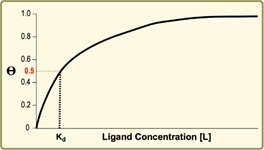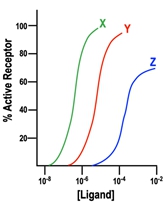So moving forward in our course, we're going to talk about a lot of different biosignalling transduction systems. But before we move forward in our course and talk about the details of all of those biosignalling transduction systems, it's important to take a step back and look at the common features that all of these biosignalling transduction systems share. And so here in this video, we're going to talk about the 5 features that pretty much all biosignalling transduction systems share. And so you can see that we have each of these 5 features numbered down below in our table. And over here on the right, what we have is images to portray each of those features. Now the very first feature here is specificity, which is really exactly what it sounds like, and it's referring to this idea that receptor ligand interactions are super, super specific. And so what this means is that receptors will not just respond to any ligand, they will only bind and respond to very specific ligands. And so over here in this image, you can see that we have our receptor, and notice that the circular green ligand here is perfectly shaped and fit for this receptor. And notice that this red square-shaped ligand over here is not fit for this receptor. And so the receptor will not respond to this ligand, however, it will respond to the circular green ligand. And so that's exactly what this idea is referring to, that the receptor-ligand interactions are super specific to each other.
And so moving on to the second feature here, what we have is amplification, which is also exactly what it sounds like, that signals will get amplified. And so this is the idea that even if you have just one single receptor-ligand interaction, ultimately that one single receptor-ligand interaction will lead to many downstream interactions. And so over here on the right hand side, you can see the portrayal of this particular feature of amplification. And so notice here we have our ligand binding to the receptor and that represents our single receptor-ligand interaction. But, ultimately, we know that it's going to lead to many, many downstream interactions, and so you can see that, ultimately, it could lead to 1 molecule getting activated, which would activate 2 molecules and then each of those would activate 2 more. And ultimately, what happens is you get many, many molecules that are affected through the interaction of just one single receptor-ligand interaction. And so that shows the amplification of the single signal.
Now our third feature here that pretty much all biosignalling transduction systems share is modularity. And this is the idea that a system's components are modular and they can be modulated or they can be modified in order to elicit many different responses, and they can be modified for many different uses. And so over here on the right, we can see a portrayal of that idea. And so notice that we have our single receptor-ligand interaction. But the biosignalling transduction system could entail modifications, and so there's one pathway that could lead to an active enzyme, which would lead to cell response number 1. But then of course the same exact receptor-ligand interaction could be modified so that its signal transduction leads to the inactivation of an enzyme, perhaps through phosphorylation like as we're showing here. And that inactivation of the enzyme could lead to cell response number 2. And so ultimately, what we're seeing here is that a biosignalling transduction system can be modulated for many uses to elicit different cell responses.
So now moving on to feature number 4, it is adaptation. And, of course, this is exactly what it sounds like, that a biosignalling transduction system can actually adapt to several different scenarios, and it can do this through positive and negative feedback regulation. And so if we take a look at this image over here, notice we're showing you again our ligand-receptor interaction right here. And notice that this signal transduction system leads to the activation of all these different enzymes, which ultimately leads to product f over here. But if product f is getting overproduced, product f can actually come back and inhibit this receptor-ligand interaction, so that it can help decrease the production of f. And so this is a way for the system to adapt to the scenario where f is overproduced. And this is showing an example of negative feedback regulation since it's inhibiting this receptor-ligand interaction, but this could also occur through positive feedback regulation as well.
And so our fifth and final feature that all biosignalling transduction systems share is integration. And, of course, this is the idea that a system can actually integrate with other systems. And so, it can therefore produce a unified and scaled cellular response, especially if these two systems are producing opposite cell response effects. And so notice over here in this image, we have 2 different biosignalling transduction systems. We have this purple and green receptor-ligand interaction, and then we have this blue and red receptor-ligand interaction. And so notice that these 2 biosignalling systems can be integrated in order to create a unified and scaled, appropriately scaled cell response. And we'll be able to see ideas of integration as we move forward in our course as well.
And so really this here concludes our lesson on the 5 features of biosignalling transduction systems, and we'll be able to see examples of all of these five features as we move forward in our course and talk about specific biosignalling transduction systems. And so that concludes this video and I'll see you guys in our next one.



